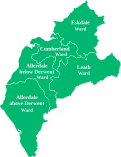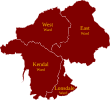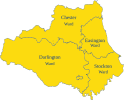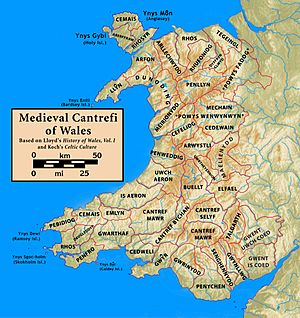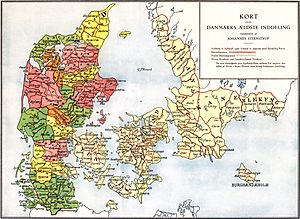Hundred (county division) facts for kids
A hundred was a type of administrative division used in many countries long ago. It was a smaller area within a larger region, like a county or a province.
Hundreds were once common in places like England, Wales, parts of the United States, and Nordic countries such as Denmark, Sweden, and Finland. They were also used in Australia and in the Ukrainian state of the Cossack Hetmanate. Today, they are still used in some parts of Australia, like South Australia and the Northern Territory.
Other names for a hundred in different languages include wapentake (in England), herred (Danish and Norwegian), härad (Swedish), satakunta (Finnish), and cantref (Welsh). In Ireland, a similar division was called a barony.
Contents
What Does "Hundred" Mean?
The exact meaning of the word "hundred" for these areas is a bit of a mystery.
Some people think it might have referred to an area of 100 "hides" of land. A "hide" was an old English measurement for land, originally enough to support a peasant family. Later, it could support more families.
Another idea is that a hundred was an area that had to provide 100 men for the army. The word "hundred" itself could sometimes mean 100 or even 120 (a "long hundred") in old times.
There was a similar system among ancient Germanic peoples. In Old High German, a huntari was a part of a larger area called a gau. But it's not clear if these two systems are directly connected.
Hundreds in England
Quick facts for kids Hundred |
|
|---|---|
| Also known as: Wapentake Ward |
|
| Category | County subdivision |
| Location | England |
| Found in | Shires |
| Possible status | Royal manor |
| Government | Hundred court |
| Subdivisions | Divisions Half hundreds Tithings Parishes |
From the 11th century, hundreds in England had different levels of power locally. They were very important for collecting taxes. Records of taxation from these divisions exist for six centuries.
Hundreds were also used to define areas for voting in Parliament between 1832 and 1885. They were even used for the first four national headcounts (censuses) from 1801 to 1841.
The number of hundreds in each county varied a lot. For example, Leicestershire had six, while Devon, which was much larger, had 32. Over time, new types of local areas were created, and these slowly took over the roles of the hundreds.
What Was a Hundred?

In southern and western England, a hundred was a part of a shire (a large county-like area). It was used for military purposes and for justice under English law.
The term "hundred" first appeared in laws around 939–946. It referred to a measure of land and the area served by a "hundred court." In the middle of England, hundreds often covered about 100 hides of land.
During the time of the Normans, hundreds were used to collect a tax called "geld." Royal officials would work with local knights and the county's sheriff to figure out how much each hundred needed to pay. Then, the local officials of the hundred were responsible for collecting the money and sending it to the king's treasury.
Above the hundred was the shire, which was controlled by a sheriff. Hundred boundaries were often different from parish or county boundaries. This meant a hundred could sometimes be split between different counties. In some counties, like Kent and Sussex, several hundreds were grouped into even larger divisions called "lathes" or "rapes."
Hundred Courts
Over time, the main jobs of the hundred became managing the law and keeping the peace. By the 12th century, the hundred court met twelve times a year. These courts helped make sure people followed the law and dealt with local issues.
For very serious crimes, the king's court had power over the hundred. The main judge was a sheriff. However, many hundreds ended up being owned by private lords. In these cases, a "steward" (an official working for the lord) would act as the judge instead of the sheriff.
The importance of hundred courts started to fade in the 1600s. Most of their powers were taken away when new county courts were set up in 1867. The last duty of hundreds, which was to pay for damages caused by riots, ended in 1886. Today, hundreds in England no longer have an administrative role.
Ward
In the four northern counties of Cumberland, Durham, Northumberland, and Westmorland, a similar division was called a "ward" instead of a hundred.
Chiltern Hundreds
The "Steward of the Chiltern Hundreds" is a special, old job in British law. It's not a real job anymore, but it's used for a specific purpose. If a member of the British Parliament wants to resign, they can't just quit. Instead, they are appointed to this old "office of the Crown." Since holding an office of the Crown makes them unable to be a Member of Parliament, they have to leave their seat.
Wapentake
A "wapentake" was like a hundred in the northern parts of England, especially where the Vikings had settled (called the Danelaw). The word "wapentake" comes from an old idea of showing agreement at a meeting by waving weapons.
The laws in wapentakes were similar to those in hundreds. In some counties, like Leicestershire, wapentakes later became known as hundreds. In others, like Lincolnshire, the term "wapentake" continued to be used.
Hundreds in Ireland
Irish counties were divided into areas called baronies.
Hundreds in Wales
In Wales, there was an ancient Celtic system of divisions called cantrefi. A cantref roughly meant "a hundred farmsteads." These divisions were very important for Welsh law. They were so old that they often marked the boundaries between different Welsh language dialects.
Each cantref had its own court. This court was made up of the main landowners of the area. A king or his representative would lead the court. The cantref court handled crimes, decided property boundaries, and dealt with inheritance issues.
Hundreds in Nordic Countries
The term hundare (meaning "hundred") was used in parts of Sweden and what is now Finland. It's thought to mean an area that had to provide 100 men to crew four war boats.
Later, this division was replaced by the term härad or Herred, which was used across the Nordic countries. This word might come from old words meaning "warband" or "war equipment." It was similar to a "skipreide," which was a coastal area responsible for providing a warship and its crew.
In Sweden, a härad was usually divided into smaller "parish" units. These divisions started to lose their importance after a government reform in 1862. A härad also served as an election district for peasant representatives in the Swedish parliament until 1866. The häradsrätt (hundred court) was the main local court until it was replaced in 1970.
Today, hundreds in Sweden have no administrative role. However, some court districts still use the name, and the term appears in some place names.
In Finland, hundreds were called kihlakunta. They remained important administrative divisions until 2009. Each kihlakunta had its own police department, court, and prosecutors. Cities often formed their own urban kihlakunta, while several rural towns belonged to a rural one. The chief official in a rural hundred was called a nimismies. His jobs included maintaining inns for travelers, transporting prisoners, and collecting taxes.
In Norway, the term herred or herad was used for rural municipalities between 1863 and 1992. Today, only a few municipalities in western Norway still use "herad" in their name.
Hundreds in Ukraine
In the 17th and 18th centuries, a "sotnia" was an administrative, legal, and military unit in the Cossack Hetmanate and Sloboda Ukraine. It was like a company in an army.
Hundreds in the United States
In the 17th century, counties in Delaware, New Jersey, and Pennsylvania were divided into hundreds. This followed the English system that the colonists knew.
Hundreds still exist in Delaware today, but they don't have any administrative role. They were used for tax reporting and voting until the 1960s. Now, their only official use is in describing land in property records.
Hundreds were also used in Maryland. For example, when Carroll County, Maryland was formed in 1836, it took several hundreds from Baltimore County and Frederick County. Some old hundred names, like Bay Hundred in Talbot County, are still used informally for geographic areas.
After the United States became independent, the term "hundred" was mostly replaced by "election district." However, the names of the old hundreds still appeared in property deeds for about 50 years.
Some early colonial settlements in Virginia also used "hundred" in their names, like Martin's Hundred and Flowerdew Hundred. Bermuda Hundred was one of the first towns established in the English colony of Virginia in 1613.
When planning how to divide new public lands in the west, Thomas Jefferson suggested dividing them into "hundreds of ten geographical miles square." However, the final law instead created the six-mile square "township" system.
Hundreds in Australia
In South Australia, land titles still record which hundred a piece of land is in. However, like the "counties" in South Australia, hundreds are not generally used when people talk about a district. Most people don't know about them unless they are dealing with land ownership.
When the land around present-day Darwin in the Northern Territory was first surveyed, it was also divided into hundreds. This was because South Australia was managing the territory at the time.
Cumberland County (where Sydney is) also had hundreds in the 19th century, but these were later removed. A hundred was traditionally 100 square miles (about 64,000 acres), but this wasn't always exact because boundaries often followed natural features like rivers or hills.
Images for kids
-
Map of the Hundreds of Staffordshire, around 1650. North is to the right.
See also
 In Spanish: Hundred (división) para niños
In Spanish: Hundred (división) para niños


